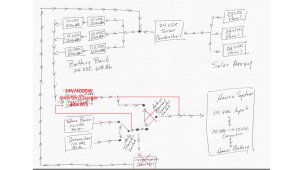dougybug
New Member
- Joined
- Oct 28, 2021
- Messages
- 17
Hello Everyone. My name is Doug. My wife and I have purchased our first RV for our retirement dream. We hope to do a great deal of boondocking, so I wanted to add a solar package to our RV. I am new to the world of solar power, but do have some electrical experience. I am trying to learn as much as I can so I do not make any costly mistakes.
I have sketched out a concept for a system and wanted to get others inputs on my idea. The sketch really only shows flow, disregarding DC polarity and fusing. I wanted to add the package with as little interference to the RV's original electrical system as possible. That is why I am not tapped into the RV's 12 VDC system. I may upgrade the onboard 12 VDC battery to a 206 Ah LiFePo battery, but that is probably the only modification I want to do to the original system.
Your thoughts, concerns and inputs will be greatly appreciated. Thank you.
Doug
I have sketched out a concept for a system and wanted to get others inputs on my idea. The sketch really only shows flow, disregarding DC polarity and fusing. I wanted to add the package with as little interference to the RV's original electrical system as possible. That is why I am not tapped into the RV's 12 VDC system. I may upgrade the onboard 12 VDC battery to a 206 Ah LiFePo battery, but that is probably the only modification I want to do to the original system.
Your thoughts, concerns and inputs will be greatly appreciated. Thank you.
Doug




